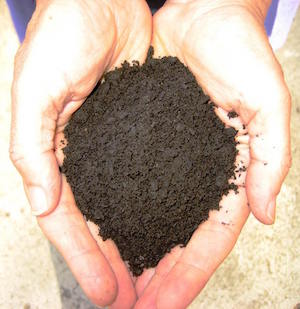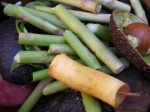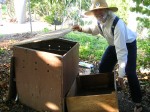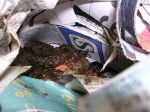Working With and Learning From Nature
When We Feed The Soil, We Feed Ourselves
Posted on May 18, 2013 by Jill Cloutier

Any time that we place compostable food scraps in the trash we are throwing away valuable natural resources. In Santa Barbara County, an estimated 700 tons of trash a day goes to our landfill and of that, about 40% is considered compostable. What happens to food scraps in the landfill? After being buried under layers of trash and dirt, food scraps begin to slowly decompose and emit Volatile Organic Compounds (VOC’s) and methane- a potent climate change causing gas.

What to do? Compost! Composting your food scraps turns your trash into treasure, saves you money on gardening inputs, and helps you become part of the solution to climate change. Composting is easy, doesn’t require a lot of space, tools or materials and offers you a crash course in observing decomposition- a much maligned and feared natural process. Finished compost is an excellent soil amendment. When you feed the soil with compost, you are improving soil tilth and providing plants with beneficial nutrients and microbes.

Here are four ways to get started on your journey of feeding the soil. By creating the conditions for compost to happen you are calling in the FBI- fungi, bacteria, and invertebrates to do the composting work for you.
1.) Compost Piles– These require the most land area, at least 3’x3’x3′. By layering dry sticks, cardboard and leaves (carbon) with food scraps, grass, and yard waste (nitrogen) you create a rich haven for composting bacteria to thrive. When your pile heats up, you’re on your way to creating your first batch of “black gold.” Be sure to keep your pile well aerated by turning it and watering it in dry climates.
2.) Compost Bins– Some people like to place their food scraps in a reclosable bin and let them decompose slowly. Sometimes this method can get a bit smelly (anaerobic), but it’s easy and convenient. The drawback is that anaerobic compost emits methane gas.
3.) Worms To The Rescue- Remember ant farms? Worm bins are worm farms where you can watch nature working for you. A fun and fascinating way to quickly and efficiently create compost, opening the lid to your worm bin is like opening the door to another world.
By layering shredded newspaper with food scraps you can turn a plastic or wooden container into a mini ecosystem, much like a forest floor. There on the surface of your bin, red wiggler worms (eisenia foetida), sow bugs, beetles, spring tails and countless other creatures will squirm and scuttle about, eating and pooping out a concentrated nutrient rich soil amendment (vermicompost). Fungi and bacteria will also join the decomposition party and their enzymes and body heat will help decompose the organic matter that you place into your bin. Worm bins are a great way to see composting in action. Don’t dig up the earth worms from your yard or garden to place in a bin. They won’t be happy. Get your red wigglers from a garden store, bait shop or from a friend.

4.) Trench Composting- If you have a shovel, you can dig a hole and bury your food scraps directly in the ground. I’ve done this when my worm bin is full and my food scraps are piling up. Make sure to bury the scraps rather deeply (at least 12″), cover them well with soil and water the area just a bit. This ensures that hungry night visitors like opossums and raccoons won’t find your buried treasure.
Composting is an investment in real homeland security. It increases soil fertility and plant health, reduces the amount of trash going to landfills, saves money and decreases methane that contributes to climate change. Composting is an easy way to participate in solutions for some of our greatest environmental challenges.
Category: Agriculture, Blog, Climate Change, Ecology, Gardening, Organics, Permaculture, Plants, Soil Tags: climate change, composting, green living, organic gardening, organics, Permaculture, santa barbara, sustainaability